Taxation Theory, Practice & Law (HI6028) Assignment: GST & CGT
VerifiedAdded on 2022/10/14
|7
|2218
|35
Homework Assignment
AI Summary
This document presents a comprehensive solution to a taxation assignment, focusing on Goods and Services Tax (GST) and Capital Gains Tax (CGT). The assignment analyzes the tax implications of a vacant land owned by the City Sky Company, determining its eligibility for GST based on residentia...
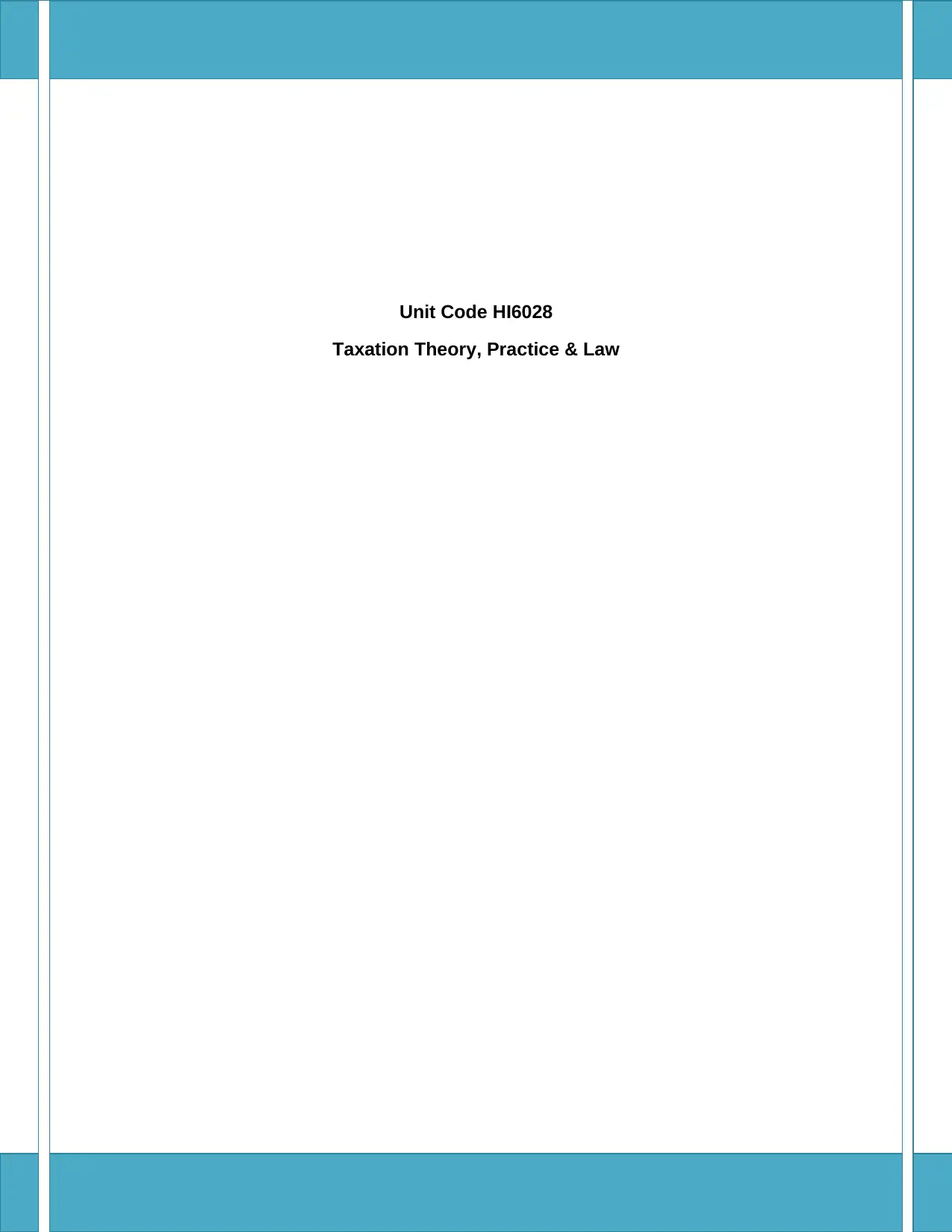
Unit Code HI6028
Taxation Theory, Practice & Law
Taxation Theory, Practice & Law
Paraphrase This Document
Need a fresh take? Get an instant paraphrase of this document with our AI Paraphraser
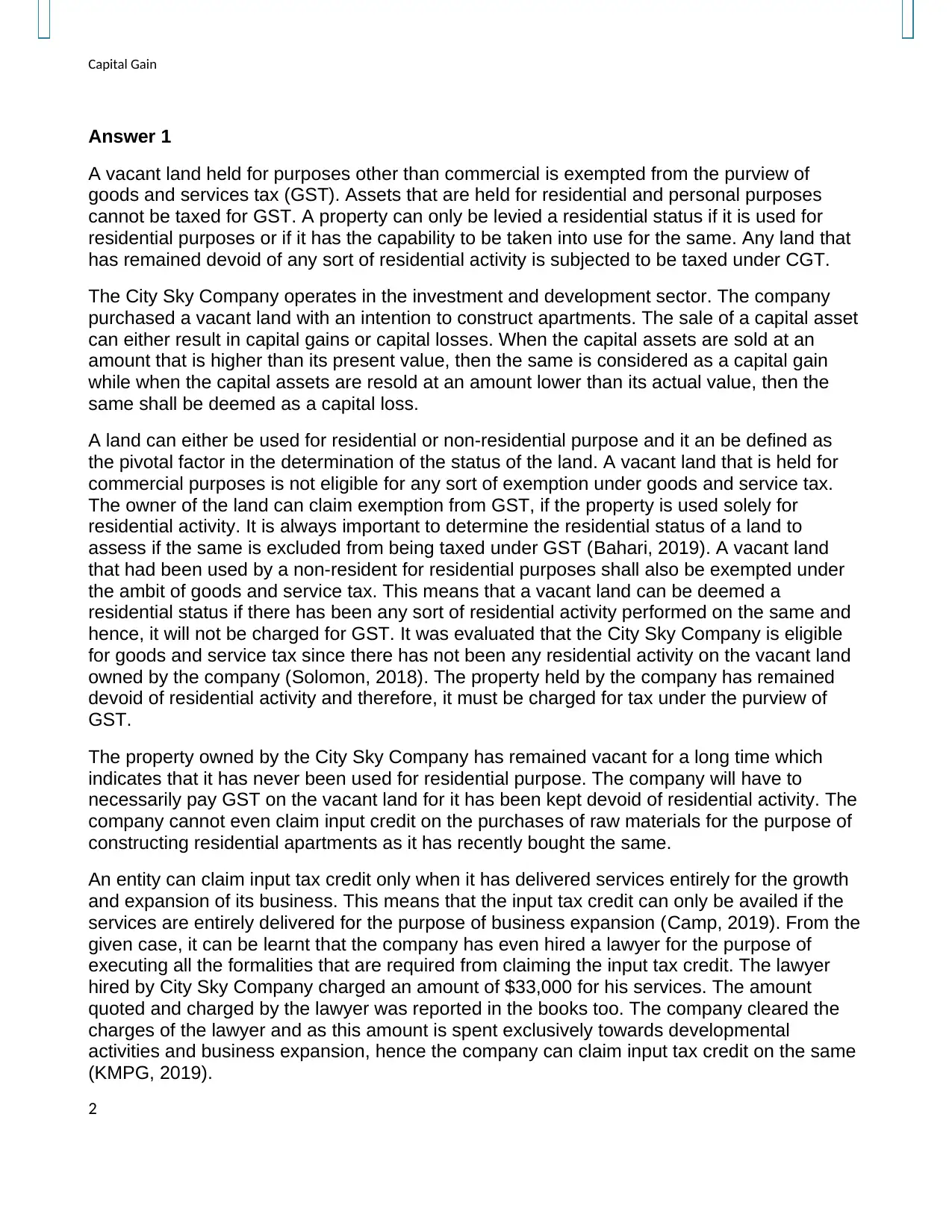
Capital Gain
Answer 1
A vacant land held for purposes other than commercial is exempted from the purview of
goods and services tax (GST). Assets that are held for residential and personal purposes
cannot be taxed for GST. A property can only be levied a residential status if it is used for
residential purposes or if it has the capability to be taken into use for the same. Any land that
has remained devoid of any sort of residential activity is subjected to be taxed under CGT.
The City Sky Company operates in the investment and development sector. The company
purchased a vacant land with an intention to construct apartments. The sale of a capital asset
can either result in capital gains or capital losses. When the capital assets are sold at an
amount that is higher than its present value, then the same is considered as a capital gain
while when the capital assets are resold at an amount lower than its actual value, then the
same shall be deemed as a capital loss.
A land can either be used for residential or non-residential purpose and it an be defined as
the pivotal factor in the determination of the status of the land. A vacant land that is held for
commercial purposes is not eligible for any sort of exemption under goods and service tax.
The owner of the land can claim exemption from GST, if the property is used solely for
residential activity. It is always important to determine the residential status of a land to
assess if the same is excluded from being taxed under GST (Bahari, 2019). A vacant land
that had been used by a non-resident for residential purposes shall also be exempted under
the ambit of goods and service tax. This means that a vacant land can be deemed a
residential status if there has been any sort of residential activity performed on the same and
hence, it will not be charged for GST. It was evaluated that the City Sky Company is eligible
for goods and service tax since there has not been any residential activity on the vacant land
owned by the company (Solomon, 2018). The property held by the company has remained
devoid of residential activity and therefore, it must be charged for tax under the purview of
GST.
The property owned by the City Sky Company has remained vacant for a long time which
indicates that it has never been used for residential purpose. The company will have to
necessarily pay GST on the vacant land for it has been kept devoid of residential activity. The
company cannot even claim input credit on the purchases of raw materials for the purpose of
constructing residential apartments as it has recently bought the same.
An entity can claim input tax credit only when it has delivered services entirely for the growth
and expansion of its business. This means that the input tax credit can only be availed if the
services are entirely delivered for the purpose of business expansion (Camp, 2019). From the
given case, it can be learnt that the company has even hired a lawyer for the purpose of
executing all the formalities that are required from claiming the input tax credit. The lawyer
hired by City Sky Company charged an amount of $33,000 for his services. The amount
quoted and charged by the lawyer was reported in the books too. The company cleared the
charges of the lawyer and as this amount is spent exclusively towards developmental
activities and business expansion, hence the company can claim input tax credit on the same
(KMPG, 2019).
2
Answer 1
A vacant land held for purposes other than commercial is exempted from the purview of
goods and services tax (GST). Assets that are held for residential and personal purposes
cannot be taxed for GST. A property can only be levied a residential status if it is used for
residential purposes or if it has the capability to be taken into use for the same. Any land that
has remained devoid of any sort of residential activity is subjected to be taxed under CGT.
The City Sky Company operates in the investment and development sector. The company
purchased a vacant land with an intention to construct apartments. The sale of a capital asset
can either result in capital gains or capital losses. When the capital assets are sold at an
amount that is higher than its present value, then the same is considered as a capital gain
while when the capital assets are resold at an amount lower than its actual value, then the
same shall be deemed as a capital loss.
A land can either be used for residential or non-residential purpose and it an be defined as
the pivotal factor in the determination of the status of the land. A vacant land that is held for
commercial purposes is not eligible for any sort of exemption under goods and service tax.
The owner of the land can claim exemption from GST, if the property is used solely for
residential activity. It is always important to determine the residential status of a land to
assess if the same is excluded from being taxed under GST (Bahari, 2019). A vacant land
that had been used by a non-resident for residential purposes shall also be exempted under
the ambit of goods and service tax. This means that a vacant land can be deemed a
residential status if there has been any sort of residential activity performed on the same and
hence, it will not be charged for GST. It was evaluated that the City Sky Company is eligible
for goods and service tax since there has not been any residential activity on the vacant land
owned by the company (Solomon, 2018). The property held by the company has remained
devoid of residential activity and therefore, it must be charged for tax under the purview of
GST.
The property owned by the City Sky Company has remained vacant for a long time which
indicates that it has never been used for residential purpose. The company will have to
necessarily pay GST on the vacant land for it has been kept devoid of residential activity. The
company cannot even claim input credit on the purchases of raw materials for the purpose of
constructing residential apartments as it has recently bought the same.
An entity can claim input tax credit only when it has delivered services entirely for the growth
and expansion of its business. This means that the input tax credit can only be availed if the
services are entirely delivered for the purpose of business expansion (Camp, 2019). From the
given case, it can be learnt that the company has even hired a lawyer for the purpose of
executing all the formalities that are required from claiming the input tax credit. The lawyer
hired by City Sky Company charged an amount of $33,000 for his services. The amount
quoted and charged by the lawyer was reported in the books too. The company cleared the
charges of the lawyer and as this amount is spent exclusively towards developmental
activities and business expansion, hence the company can claim input tax credit on the same
(KMPG, 2019).
2

Capital Gain
The lawyer charged a total of $300,000 for his services and the minimum amount for getting
qualified is $75,000. This means that the company can easily avail input tax credit on the GST
paid.
3
The lawyer charged a total of $300,000 for his services and the minimum amount for getting
qualified is $75,000. This means that the company can easily avail input tax credit on the GST
paid.
3
⊘ This is a preview!⊘
Do you want full access?
Subscribe today to unlock all pages.

Trusted by 1+ million students worldwide
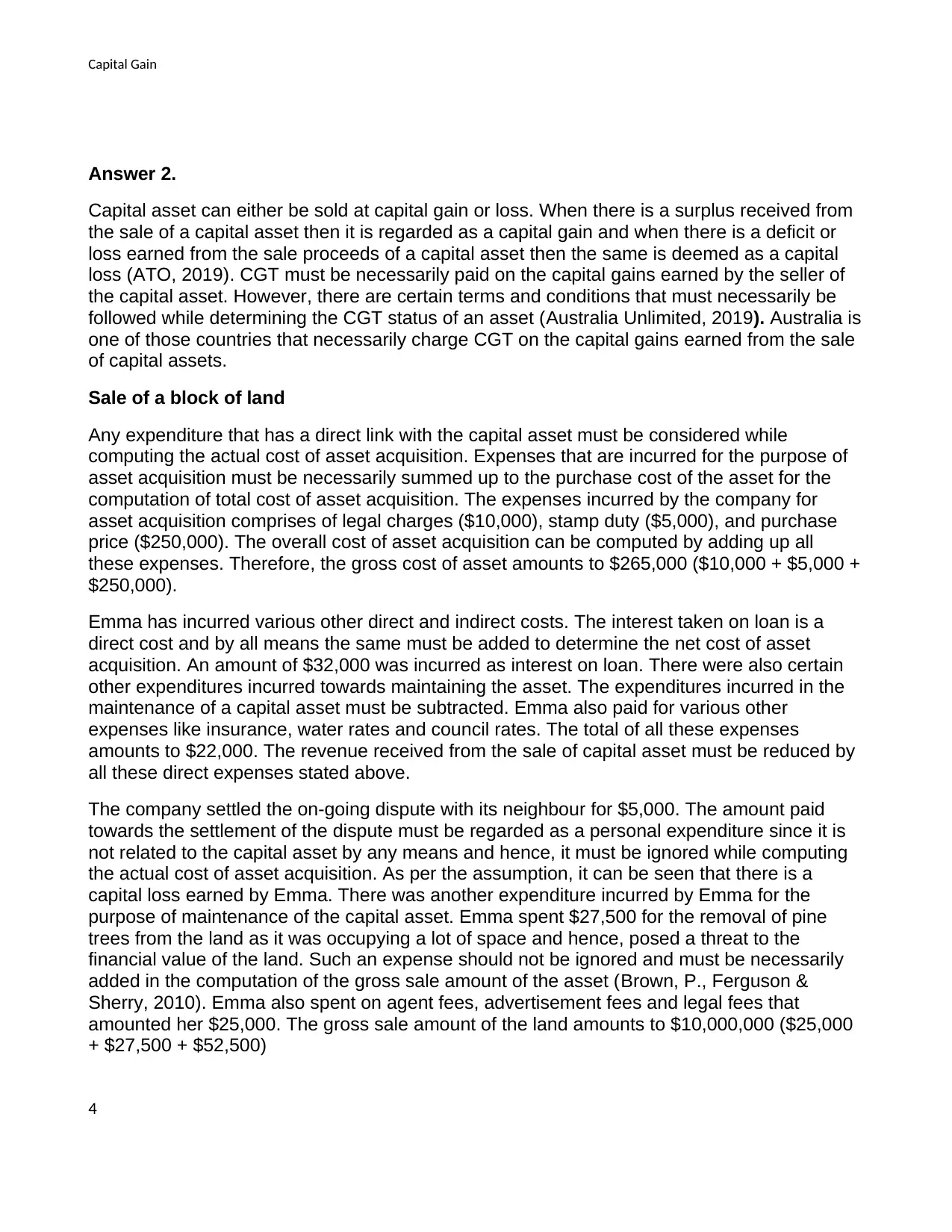
Capital Gain
Answer 2.
Capital asset can either be sold at capital gain or loss. When there is a surplus received from
the sale of a capital asset then it is regarded as a capital gain and when there is a deficit or
loss earned from the sale proceeds of a capital asset then the same is deemed as a capital
loss (ATO, 2019). CGT must be necessarily paid on the capital gains earned by the seller of
the capital asset. However, there are certain terms and conditions that must necessarily be
followed while determining the CGT status of an asset (Australia Unlimited, 2019). Australia is
one of those countries that necessarily charge CGT on the capital gains earned from the sale
of capital assets.
Sale of a block of land
Any expenditure that has a direct link with the capital asset must be considered while
computing the actual cost of asset acquisition. Expenses that are incurred for the purpose of
asset acquisition must be necessarily summed up to the purchase cost of the asset for the
computation of total cost of asset acquisition. The expenses incurred by the company for
asset acquisition comprises of legal charges ($10,000), stamp duty ($5,000), and purchase
price ($250,000). The overall cost of asset acquisition can be computed by adding up all
these expenses. Therefore, the gross cost of asset amounts to $265,000 ($10,000 + $5,000 +
$250,000).
Emma has incurred various other direct and indirect costs. The interest taken on loan is a
direct cost and by all means the same must be added to determine the net cost of asset
acquisition. An amount of $32,000 was incurred as interest on loan. There were also certain
other expenditures incurred towards maintaining the asset. The expenditures incurred in the
maintenance of a capital asset must be subtracted. Emma also paid for various other
expenses like insurance, water rates and council rates. The total of all these expenses
amounts to $22,000. The revenue received from the sale of capital asset must be reduced by
all these direct expenses stated above.
The company settled the on-going dispute with its neighbour for $5,000. The amount paid
towards the settlement of the dispute must be regarded as a personal expenditure since it is
not related to the capital asset by any means and hence, it must be ignored while computing
the actual cost of asset acquisition. As per the assumption, it can be seen that there is a
capital loss earned by Emma. There was another expenditure incurred by Emma for the
purpose of maintenance of the capital asset. Emma spent $27,500 for the removal of pine
trees from the land as it was occupying a lot of space and hence, posed a threat to the
financial value of the land. Such an expense should not be ignored and must be necessarily
added in the computation of the gross sale amount of the asset (Brown, P., Ferguson &
Sherry, 2010). Emma also spent on agent fees, advertisement fees and legal fees that
amounted her $25,000. The gross sale amount of the land amounts to $10,000,000 ($25,000
+ $27,500 + $52,500)
4
Answer 2.
Capital asset can either be sold at capital gain or loss. When there is a surplus received from
the sale of a capital asset then it is regarded as a capital gain and when there is a deficit or
loss earned from the sale proceeds of a capital asset then the same is deemed as a capital
loss (ATO, 2019). CGT must be necessarily paid on the capital gains earned by the seller of
the capital asset. However, there are certain terms and conditions that must necessarily be
followed while determining the CGT status of an asset (Australia Unlimited, 2019). Australia is
one of those countries that necessarily charge CGT on the capital gains earned from the sale
of capital assets.
Sale of a block of land
Any expenditure that has a direct link with the capital asset must be considered while
computing the actual cost of asset acquisition. Expenses that are incurred for the purpose of
asset acquisition must be necessarily summed up to the purchase cost of the asset for the
computation of total cost of asset acquisition. The expenses incurred by the company for
asset acquisition comprises of legal charges ($10,000), stamp duty ($5,000), and purchase
price ($250,000). The overall cost of asset acquisition can be computed by adding up all
these expenses. Therefore, the gross cost of asset amounts to $265,000 ($10,000 + $5,000 +
$250,000).
Emma has incurred various other direct and indirect costs. The interest taken on loan is a
direct cost and by all means the same must be added to determine the net cost of asset
acquisition. An amount of $32,000 was incurred as interest on loan. There were also certain
other expenditures incurred towards maintaining the asset. The expenditures incurred in the
maintenance of a capital asset must be subtracted. Emma also paid for various other
expenses like insurance, water rates and council rates. The total of all these expenses
amounts to $22,000. The revenue received from the sale of capital asset must be reduced by
all these direct expenses stated above.
The company settled the on-going dispute with its neighbour for $5,000. The amount paid
towards the settlement of the dispute must be regarded as a personal expenditure since it is
not related to the capital asset by any means and hence, it must be ignored while computing
the actual cost of asset acquisition. As per the assumption, it can be seen that there is a
capital loss earned by Emma. There was another expenditure incurred by Emma for the
purpose of maintenance of the capital asset. Emma spent $27,500 for the removal of pine
trees from the land as it was occupying a lot of space and hence, posed a threat to the
financial value of the land. Such an expense should not be ignored and must be necessarily
added in the computation of the gross sale amount of the asset (Brown, P., Ferguson &
Sherry, 2010). Emma also spent on agent fees, advertisement fees and legal fees that
amounted her $25,000. The gross sale amount of the land amounts to $10,000,000 ($25,000
+ $27,500 + $52,500)
4
Paraphrase This Document
Need a fresh take? Get an instant paraphrase of this document with our AI Paraphraser
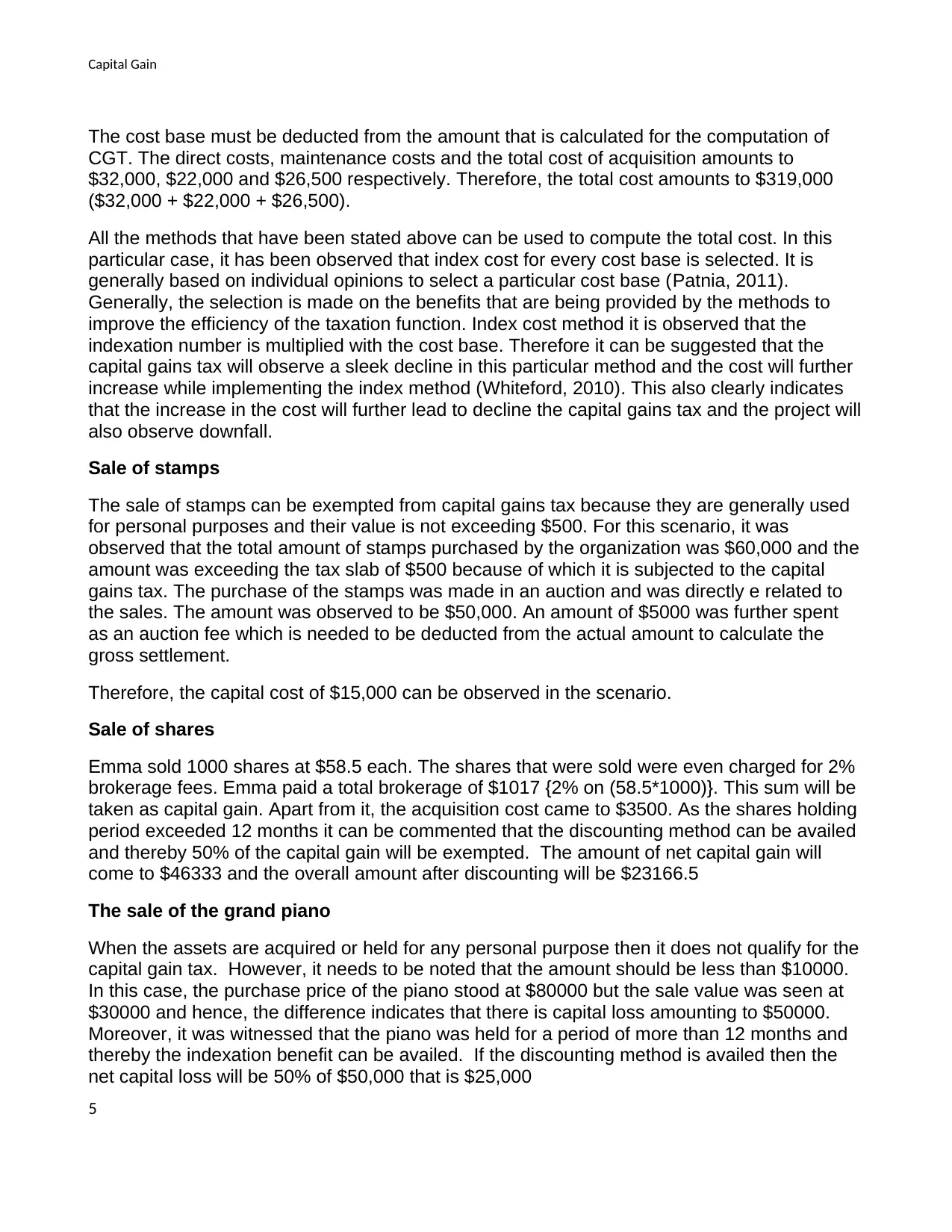
Capital Gain
The cost base must be deducted from the amount that is calculated for the computation of
CGT. The direct costs, maintenance costs and the total cost of acquisition amounts to
$32,000, $22,000 and $26,500 respectively. Therefore, the total cost amounts to $319,000
($32,000 + $22,000 + $26,500).
All the methods that have been stated above can be used to compute the total cost. In this
particular case, it has been observed that index cost for every cost base is selected. It is
generally based on individual opinions to select a particular cost base (Patnia, 2011).
Generally, the selection is made on the benefits that are being provided by the methods to
improve the efficiency of the taxation function. Index cost method it is observed that the
indexation number is multiplied with the cost base. Therefore it can be suggested that the
capital gains tax will observe a sleek decline in this particular method and the cost will further
increase while implementing the index method (Whiteford, 2010). This also clearly indicates
that the increase in the cost will further lead to decline the capital gains tax and the project will
also observe downfall.
Sale of stamps
The sale of stamps can be exempted from capital gains tax because they are generally used
for personal purposes and their value is not exceeding $500. For this scenario, it was
observed that the total amount of stamps purchased by the organization was $60,000 and the
amount was exceeding the tax slab of $500 because of which it is subjected to the capital
gains tax. The purchase of the stamps was made in an auction and was directly e related to
the sales. The amount was observed to be $50,000. An amount of $5000 was further spent
as an auction fee which is needed to be deducted from the actual amount to calculate the
gross settlement.
Therefore, the capital cost of $15,000 can be observed in the scenario.
Sale of shares
Emma sold 1000 shares at $58.5 each. The shares that were sold were even charged for 2%
brokerage fees. Emma paid a total brokerage of $1017 {2% on (58.5*1000)}. This sum will be
taken as capital gain. Apart from it, the acquisition cost came to $3500. As the shares holding
period exceeded 12 months it can be commented that the discounting method can be availed
and thereby 50% of the capital gain will be exempted. The amount of net capital gain will
come to $46333 and the overall amount after discounting will be $23166.5
The sale of the grand piano
When the assets are acquired or held for any personal purpose then it does not qualify for the
capital gain tax. However, it needs to be noted that the amount should be less than $10000.
In this case, the purchase price of the piano stood at $80000 but the sale value was seen at
$30000 and hence, the difference indicates that there is capital loss amounting to $50000.
Moreover, it was witnessed that the piano was held for a period of more than 12 months and
thereby the indexation benefit can be availed. If the discounting method is availed then the
net capital loss will be 50% of $50,000 that is $25,000
5
The cost base must be deducted from the amount that is calculated for the computation of
CGT. The direct costs, maintenance costs and the total cost of acquisition amounts to
$32,000, $22,000 and $26,500 respectively. Therefore, the total cost amounts to $319,000
($32,000 + $22,000 + $26,500).
All the methods that have been stated above can be used to compute the total cost. In this
particular case, it has been observed that index cost for every cost base is selected. It is
generally based on individual opinions to select a particular cost base (Patnia, 2011).
Generally, the selection is made on the benefits that are being provided by the methods to
improve the efficiency of the taxation function. Index cost method it is observed that the
indexation number is multiplied with the cost base. Therefore it can be suggested that the
capital gains tax will observe a sleek decline in this particular method and the cost will further
increase while implementing the index method (Whiteford, 2010). This also clearly indicates
that the increase in the cost will further lead to decline the capital gains tax and the project will
also observe downfall.
Sale of stamps
The sale of stamps can be exempted from capital gains tax because they are generally used
for personal purposes and their value is not exceeding $500. For this scenario, it was
observed that the total amount of stamps purchased by the organization was $60,000 and the
amount was exceeding the tax slab of $500 because of which it is subjected to the capital
gains tax. The purchase of the stamps was made in an auction and was directly e related to
the sales. The amount was observed to be $50,000. An amount of $5000 was further spent
as an auction fee which is needed to be deducted from the actual amount to calculate the
gross settlement.
Therefore, the capital cost of $15,000 can be observed in the scenario.
Sale of shares
Emma sold 1000 shares at $58.5 each. The shares that were sold were even charged for 2%
brokerage fees. Emma paid a total brokerage of $1017 {2% on (58.5*1000)}. This sum will be
taken as capital gain. Apart from it, the acquisition cost came to $3500. As the shares holding
period exceeded 12 months it can be commented that the discounting method can be availed
and thereby 50% of the capital gain will be exempted. The amount of net capital gain will
come to $46333 and the overall amount after discounting will be $23166.5
The sale of the grand piano
When the assets are acquired or held for any personal purpose then it does not qualify for the
capital gain tax. However, it needs to be noted that the amount should be less than $10000.
In this case, the purchase price of the piano stood at $80000 but the sale value was seen at
$30000 and hence, the difference indicates that there is capital loss amounting to $50000.
Moreover, it was witnessed that the piano was held for a period of more than 12 months and
thereby the indexation benefit can be availed. If the discounting method is availed then the
net capital loss will be 50% of $50,000 that is $25,000
5
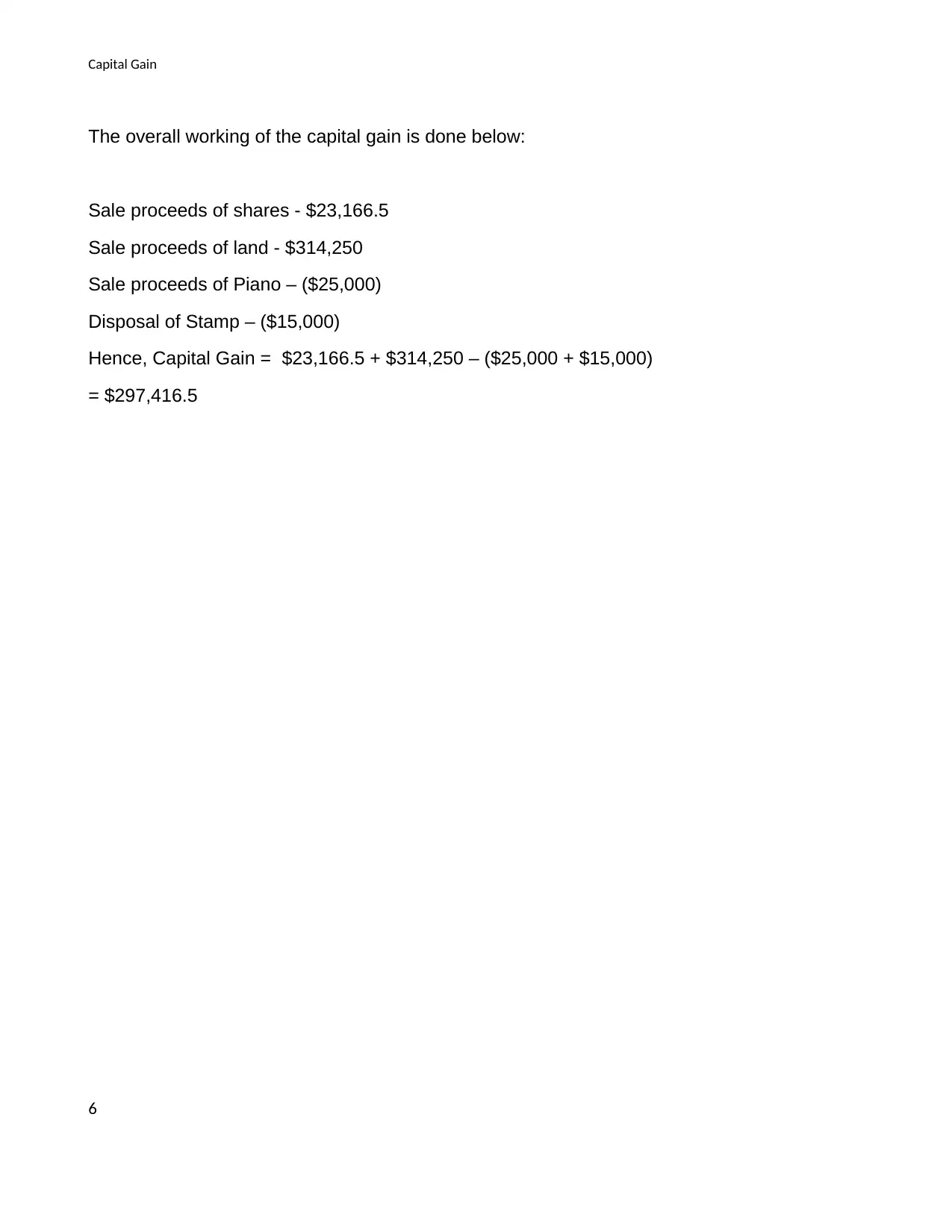
Capital Gain
The overall working of the capital gain is done below:
Sale proceeds of shares - $23,166.5
Sale proceeds of land - $314,250
Sale proceeds of Piano – ($25,000)
Disposal of Stamp – ($15,000)
Hence, Capital Gain = $23,166.5 + $314,250 – ($25,000 + $15,000)
= $297,416.5
6
The overall working of the capital gain is done below:
Sale proceeds of shares - $23,166.5
Sale proceeds of land - $314,250
Sale proceeds of Piano – ($25,000)
Disposal of Stamp – ($15,000)
Hence, Capital Gain = $23,166.5 + $314,250 – ($25,000 + $15,000)
= $297,416.5
6
⊘ This is a preview!⊘
Do you want full access?
Subscribe today to unlock all pages.

Trusted by 1+ million students worldwide

Capital Gain
References
ATO 2019, Capital gains Tax 2019, viewed on 26 September 2019,
https://www.ato.gov.au/General/Capital-gains-tax/
Australia Unlimited 2019, Australian business taxes, viewed 27 September 2019,
https://www.austrade.gov.au/International/Invest/Guide-to-investing/Running-a-
business/Understanding-Australian-taxes/Australian-business-taxes
Brown, P., Ferguson, A., & Sherry, S 2010, Investor behaviour in response to Australia's
capital gains tax, Accounting and Finance, vol. 50, no. 4, pp. 783, viewed 27 September 2019
<https://search.proquest.com/docview/762714715?accountid=30552
Patnia, A 2011, No Capital gain tax or income tax on profit on sale of a car or other personal
effect, viewed 20 September 2019, https://taxmantra.com/capital-gain-tax-income-tax-
profit-sale-car-personal-effect/
Bahari, N 2019, What is GST and how does it work?, viewed on 27 September 2019 <
https://legalvision.com.au/what-is-gst-and-how-does-it-work/>
Solomon, J 2019, Understanding Australian GST: A Guide for SaaS Companies, viewed on
13 September 2019 < https://www.chargebee.com/blog/gst-australian-saas-founders-heres/>
Camp, A 2019, How to avoid capital gains tax when selling property, viewed 23 September
2019, https://www.finder.com/avoid-capital-gains-tax-when-selling-property
KMPG 2019, New GST rules for property developers, viewed on 27 September 2019,
https://home.kpmg/au/en/home/insights/2018/05/gst-rules-for-property-developers-
from-july-2018.html>
Whiteford, P 2010, The Australian tax-transfer system: Architecture and outcomes. Economic
Record, vol. 86, no. 275, pp.528-537, doi:10.1111/j.1475-4932.2010.00634.x
7
References
ATO 2019, Capital gains Tax 2019, viewed on 26 September 2019,
https://www.ato.gov.au/General/Capital-gains-tax/
Australia Unlimited 2019, Australian business taxes, viewed 27 September 2019,
https://www.austrade.gov.au/International/Invest/Guide-to-investing/Running-a-
business/Understanding-Australian-taxes/Australian-business-taxes
Brown, P., Ferguson, A., & Sherry, S 2010, Investor behaviour in response to Australia's
capital gains tax, Accounting and Finance, vol. 50, no. 4, pp. 783, viewed 27 September 2019
<https://search.proquest.com/docview/762714715?accountid=30552
Patnia, A 2011, No Capital gain tax or income tax on profit on sale of a car or other personal
effect, viewed 20 September 2019, https://taxmantra.com/capital-gain-tax-income-tax-
profit-sale-car-personal-effect/
Bahari, N 2019, What is GST and how does it work?, viewed on 27 September 2019 <
https://legalvision.com.au/what-is-gst-and-how-does-it-work/>
Solomon, J 2019, Understanding Australian GST: A Guide for SaaS Companies, viewed on
13 September 2019 < https://www.chargebee.com/blog/gst-australian-saas-founders-heres/>
Camp, A 2019, How to avoid capital gains tax when selling property, viewed 23 September
2019, https://www.finder.com/avoid-capital-gains-tax-when-selling-property
KMPG 2019, New GST rules for property developers, viewed on 27 September 2019,
https://home.kpmg/au/en/home/insights/2018/05/gst-rules-for-property-developers-
from-july-2018.html>
Whiteford, P 2010, The Australian tax-transfer system: Architecture and outcomes. Economic
Record, vol. 86, no. 275, pp.528-537, doi:10.1111/j.1475-4932.2010.00634.x
7
1 out of 7
Related Documents
Your All-in-One AI-Powered Toolkit for Academic Success.
+13062052269
info@desklib.com
Available 24*7 on WhatsApp / Email
![[object Object]](/_next/static/media/star-bottom.7253800d.svg)
Unlock your academic potential
© 2024 | Zucol Services PVT LTD | All rights reserved.





